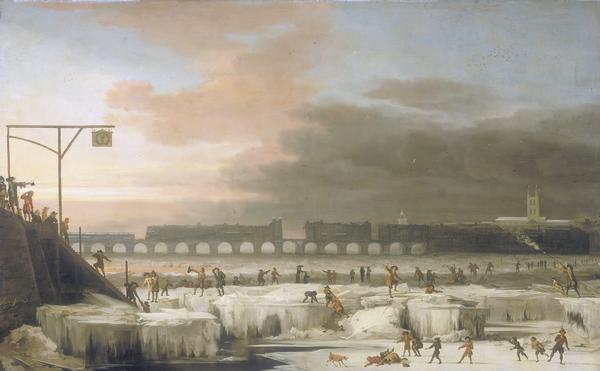The money for the original construction of the bridge was raised in part by allowing the land on the bridge to be sold for dwellings. By Stuart times there were more than two hundred buildings on the bridge, both residential and commercial. Some stood up as high as seven storeys and overhung the river by several feet. This picture shows just how far out they protruded.
In the middle of the bridge was a Chapel to St Thomas Becket, built by King Henry II, which became the official start of pilgrimages to Becket's shrine at Canterbury. This chapel actusally took 33 years to complete, and was not finished in Henry's lifetime. King John had to license out more building plots on the bridge to help recoup the costs of Henry's repentance.
Looking at these pictures of London Bridge you can see that the buildings were truly monumental.
_by_Claes_Van_Visscher.jpg)
So tall-ships could pass upriver there was a drawbridge, and there were defensive gatehouses at both ends, one of which supported a tower on which traitor's heads used to be displayed on iron spikes. This practice was finally stopped in 1660, following the Restoration, presumably so as not to remind the King of the fate of his father! You can see traitors heads on this print by Visscher from 1616, which was the nearest image I could find in my research with detail of the bridge, although there is doubt now as to its accuracy as it was copied (with a degree of artistic licence) from an earlier drawing.
The buildings on London Bridge were a major fire hazard and in 1212, perhaps the greatest of the fires broke out on both ends of the bridge, trapping many in the middle as the flames at each end raged towards each other, resulting in the death of an estimated 3,000 people. Houses on the bridge were also burnt during the Peasants Revolt in 1381. As for the period I am interested in, a major fire had destroyed a third of the bridge in 1633, but this was fortunate as it formed a firebreak that prevented further damage to the bridge during The Great Fire of 1666.
The width of the actual bridge was about 4 metres, and it was divided into two lanes, so that whichever way you went, whether in a coach and horses, with a wagon or on foot, you had to negotiate a road only 2 metres wide. No wonder the bridge was congested and crossing it could take up to an hour! Those who could afford the fare might prefer to cross by ferry but as I discovered, the actual bridge structure made passing under it by boat quite dangerous.
To support this amount of wood and masonry nineteen arches had been made, none of which were the same dimensions because the river bed was tidal and the foundations uneven, so the 'legs' or piers were built onto boat shaped structures called "starlings" set into the river-bed. The narrow arches and wide pier bases restricted the river's tidal ebb and flow so, that in hard winters, the water upstream of the bridge became more susceptible to freezing. In The Gilded Lily I use the frozen Thames, and the Frost Fair upon it, as one of the settings.
By the 17th century the flow was further obstructed as waterwheels had been installed under the two north arches to drive water pumps, and under the two south arches to power mills and granaries. At the time my novel is set there was a difference in water levels on each side of the bridge. Negotiating it meant braving rapids with a drop of almost two metres. Most boats stopped on one side, allowed passengers to alight, and then they had to pick up a boat further downstream.
Because the river flowed much more slowly above the bridge it often froze. In the 17th century because temperatures were lower and it was known as The Little Ice Age it froze several times.The tidal nature of the river meant that plates of ice formed and then the level of the river would rise again and create vast layered platforms or glaciers of ice. This picture by Hondius of 1677 shows London Bridge in the background and the amazing glacial landscape of the Thames in the foreground.
Because the river flowed much more slowly above the bridge it often froze. In the 17th century because temperatures were lower and it was known as The Little Ice Age it froze several times.The tidal nature of the river meant that plates of ice formed and then the level of the river would rise again and create vast layered platforms or glaciers of ice. This picture by Hondius of 1677 shows London Bridge in the background and the amazing glacial landscape of the Thames in the foreground.

"Thousands and thousands to the river flocks,
Where mighty flakes of Ice do lye like Rocks,
There may you see the Coaches swiftly run
As if beneath the Ice were Waters none,
And sholes of people every where there be
Just like to herrings in the brackish Sea."
Excerpt from a long poem about a Frost Fair from a Print of 1684.
THE GILDED LILY is out now, here's the trailer - enjoy!
